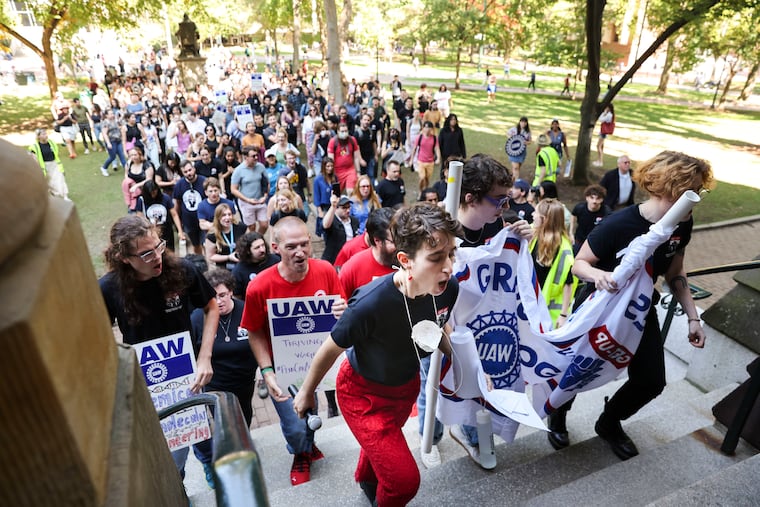Months after Penn residents formed Philly’s biggest new union in 50 years, Penn grad student workers want to break that record again
The student researchers and instructors made a plea to university leaders, asking that they stay neutral ahead of a union election rather than discouraging workers from unionizing.

Graduate student workers at the University of Pennsylvania are seeking a union election, marking the third major organizing drive at the university in less than a year.
If they’re successful, they will have created a bargaining unit of 4,500 workers — the largest union to take shape in recent history at Penn, which employs more people in Philadelphia than any other business. It would also be the biggest new union in the city in at least 50 years.
Organizing efforts have been led by GET-UP (which stands for Graduate Employees Together University of Pennsylvania), and they are looking to join the United Auto Workers union. Despite what the name suggests, UAW represents workers in more industries beyond auto manufacturing, including a number of student-worker organizations at universities.
It’s been a long road for GET-UP, which was founded in 2000. The organization pursued union recognition from the university in 2003 and 2017, but those campaigns were ultimately unsuccessful.
Organizers say they’re aiming to win higher wages, protections against harassment and discrimination, comprehensive health-care benefits, and stronger rights for international student workers, among other improvements to their working conditions.
The student workers filed paperwork with the National Labor Relations Board (NLRB) on Friday afternoon, after months of gathering union authorization cards from prospective members. According to GET-UP, about 3,000 student workers submitted authorization cards, including hundreds within the last week.
“A majority of graduate workers have already spoken,” said Sam Franz, a graduate student worker in the History and Sociology of Science Department. “Penn should respect that democratic mandate and allow us a speedy and fair election.”
In a statement Friday, Penn spokesperson Ron Ozio acknowledged the NLRB filing and said the university would await word from the board “on voter eligibility and election information.”
“Penn is proud of its collaborative culture and the many ways in which the University and its graduate students jointly address student concerns and enhance the academic experience,” Ozio said. “We encourage students to learn as much as they can about what unionization might mean for them.”
GET-UP also delivered a letter to university administration on Wednesday, asking them to “respect the democratic will and self-determination of university employees” and refrain from trying to persuade workers not to unionize.
“We have closely followed the efforts of other Penn workers to unionize. We’ve been disheartened to see the university administration’s delays, spurious legal objections, and refusal to listen to majorities of museum employees, resident physicians, and residential advisers who seek to unionize,” said GET-UP’s letter, signed by more than 600 student workers.
When Penn’s resident assistants (RAs) filed their union petition earlier this year, the university’s lawyers challenged it, arguing that the students were temporary workers and not employees under the law that governs unionization. The NLRB rejected that argument, allowing the election to proceed.
Last month, the RAs voted in favor of representation by the Office and Professional Employees International Union Local 153. The vote tally was 142-22, with about 75% turning out to cast a ballot.
Resident physicians at Penn Medicine voted in May to be represented by the Committee of Interns and Residents (CIR), becoming the first unionized training doctors in Pennsylvania. With more than 1,000 votes tallied, 89% were in favor of unionization, creating a union of about 1,400 doctors.
Leading up to that election, the resident physicians said they received emails and texts from the university about the downsides of unionizing. Signs around campus during the election urged the training doctors to “Give us a chance” and “Vote No.”
Penn’s CIR became the biggest new union to be founded in Philadelphia in more than 50 years. But GET-UP, if successful, would break that record again.
This year’s organizers follow in the footsteps of workers at the Penn Museum, who unionized in 2021 and ratified a first contract in June.
Solidarity among groups of organized workers is common, and the existing unions and union hopefuls at Penn have been collaborating more closely of late. The newly formed Coalition of Workers at Penn was created to unite Penn’s new unions, workers who have yet to organize, and existing unions that have represented other campus employees for decades. The coalition held its first open meeting on campus in September.
Student workers at the University of California, Harvard University, New York University, Columbia University, and others have organized with UAW in recent years.
A 2016 NLRB ruling paved the way for student workers at private colleges to unionize, but the wave of organizing began to build in earnest after the election of President Joe Biden, who has branded himself as a pro-union president and appointed union-friendly officials to key labor posts.
A previous version of this article said the Penn Museum Union was still negotiating a first contract. A contract was reached in June.